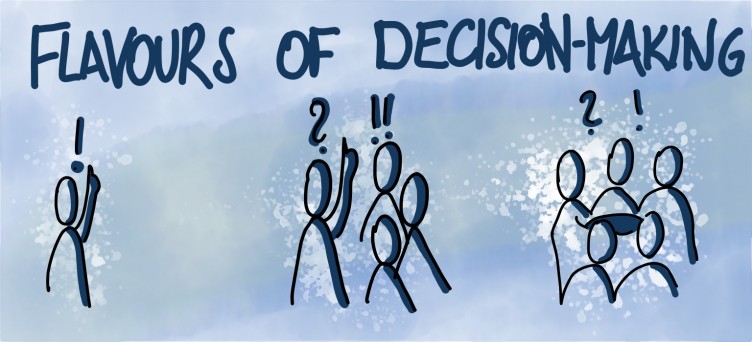Does your organization have a defined way of taking decisions? While the need for a decision on a certain issue is easy to see, we often have less clarity who’s making what decision and how input will be handled. This can either lead to unnecessary delays – when we avoid decisions – or frustrations – when we don’t involve the wider group and miss important information.
It is thus useful to set clear expectations about the process of decision-making. In general, we all use three main modes [1] of decision-making – depending on the specific context of the decision:
Autonomous: Tell & Sell
In this mode, the decision-maker (an individual or group) takes the decision without further input from the wider group. This is often the fastest way, but might lead to a lower quality of decisions if relevant information is overlooked. Important here: don’t forget to communicate the decision if it affects others or you need support for its implementation.
“We are going to go with Option A because…”
Consultative: Test & Consult
In this mode, the decision-maker solicits input from the wider group before taking the final decision themselves. This can happen either before or after developing a specific proposal. Important here: close the loop after you’ve received input and get back to people with your final decision.
“We are thinking of going ahead with Option A. Anyone have major concerns about this?”
“We need to develop a way forward for Issue B. What are your thoughts? “
Consensual: Cocreate & Agree
In this mode, decision-making power is delegated to the wider group and people with authority are participating as equals. This usually requires a formal decision-making process such as majority vote, consensus or modified versions. Important here: as a leader, honour decisions taken in this mode even if you don’t like the outcome.
“Let’s take a vote whether to go ahead with Option A.”
Next time you take a decision that affects others, try to communicate clearly about the process you will be using to take the decision. Feel free to use the model above. Remember that the process you use impacts on whether or not the decision will be accepted by the wider group – and how it will be implemented.
As a general rule: If you err, it’s usually better to err on the side of inclusivity. (Except when it isn’t. Decision-makers shouldn’t be wishy-washy about doing their jobs. It creates confusion and often more resistance.)
[1] This is based on old management wisdom, first described by Tannenbaum and Schmidt in 1958 in the Harvard Business Review, and picked up by Bryan Smith in the Fifth Discipline Fieldbook. Jürgen Appelo also uses a version of it in Management 3.0.

